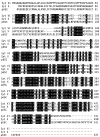A novel seizure-induced synaptotagmin gene identified by differential display
- PMID: 9122248
- PMCID: PMC20141
- DOI: 10.1073/pnas.94.6.2638
A novel seizure-induced synaptotagmin gene identified by differential display
Abstract
Systemic administration of kainic acid, a cyclic analogue of glutamate, produces many of the clinical features of human temporal lobe epilepsy and status epilepticus in rats, including the induction of motor convulsions and the degeneration of neurons in the hippocampus and piriform cortex. Differential display PCR was used to identify mRNAs that are differentially expressed between degenerating and nondegenerating tissues in the brain after kainic acid-induced seizure activity. A novel cDNA fragment expressed in the degenerating hippocampus and piriform cortex, but not in the nondegenerating parietal cortex, was identified, cloned, and sequenced. This novel cDNA fragment identified a new member of the synaptotagmin gene family that is rapidly and transiently induced in response to seizure activity. Differential expression of this synaptotagmin gene, syt X, was confirmed by Northern blot analysis and in situ hybridization. This novel, inducible synaptotagmin gene may provide a direct link between seizure-induced neuronal gene expression and subsequent modulation of synaptic structure and function.
Figures




References
Publication types
MeSH terms
Substances
Associated data
- Actions
LinkOut - more resources
Full Text Sources
Other Literature Sources
Medical
Molecular Biology Databases

